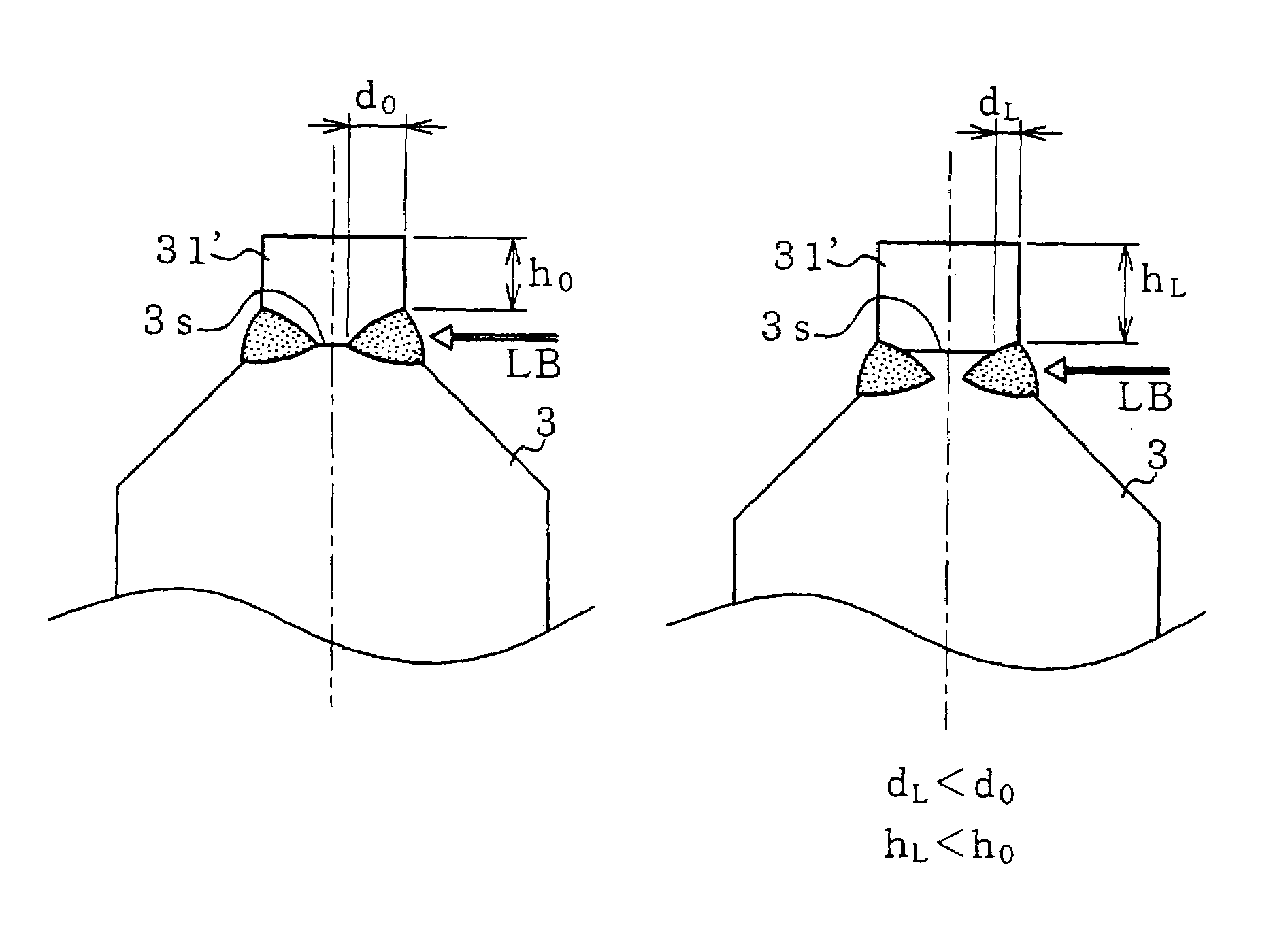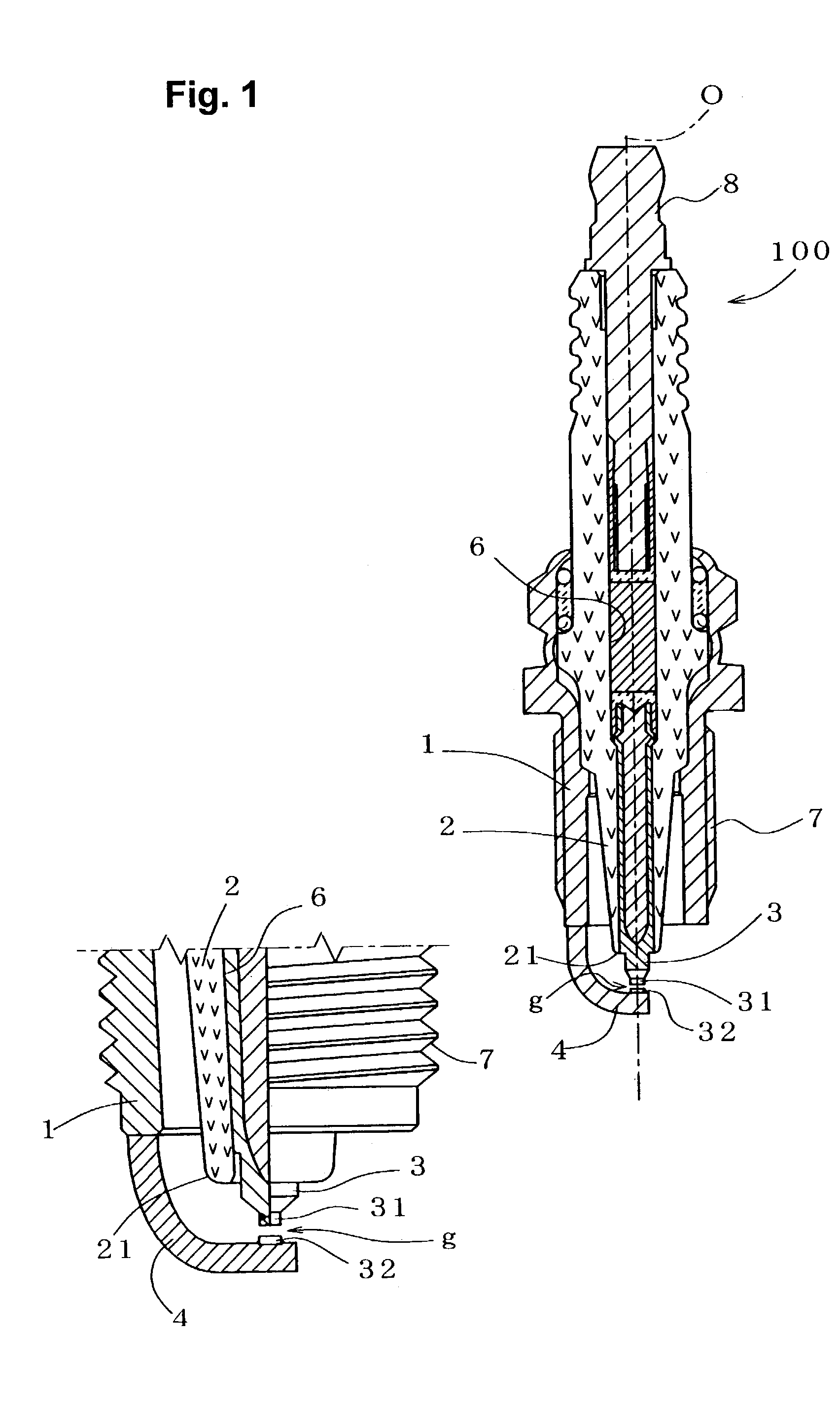[0007]It is therefore an object of the invention to provide a method and an apparatus for manufacturing a spark plug which avoid depth insufficiency of the weld metal portion and thickness insufficiency of the spark portion, and which thus enhances the
weld strength and service life of the spark portion.
[0015]The inventors have carried out extensive studies, and as a result have found that, when
laser beam welding is employed for forming a full-circled weld metal portion that joins a noble metal chip to a center electrode, a variation in the position of
irradiation with a laser beam causes the depth insufficiency of a weld metal portion or the thickness insufficiency of a spark portion. After carrying out further studies, the inventors found that control of the position of
irradiation with a laser beam relative to the chip joint face as viewed along the axial direction of the center electrode is effective for solving the above-mentioned problems. Specifically, the position of the chip joint face of the center electrode as viewed along the axial direction of the center electrode is detected, and, on the basis of the detected position, the position of irradiation with the laser beam on the chip-attached assembly as viewed along the axial direction is adjusted; i.e., whenever the laser-beam weld metal portion is to be formed, on the basis of the detected position of the chip joint face, the position of irradiation with a laser beam is adjusted to a predetermined target position, thereby optimizing at all times the spark portion thickness and the depth of the laser-beam weld metal portion, which is formed in such a manner as to intrude into the noble metal chip and into a chip joint face formation portion of the center electrode, thereby yielding a
marked effect of enhancing the separation resistance of the spark portion and extending the service life of the spark portion.
[0016]In the manufacture of spark plugs of different models, for example, spark plugs of different spark-portion specifications such as different materials for the noble metal chip or center electrode, the position of irradiation with a laser beam at which the weld metal portion depth and the spark portion thickness can be optimized is experimentally obtained beforehand for each different spark-portion specification. When the model of spark plugs to be manufactured is changed, the optimum position of irradiation with a laser beam for the different model is employed. For example, since an Ir-based noble metal chip has a
melting point that is hundreds of ° C. higher than that of a Pt-based noble metal chip, when the same position of irradiation with a laser beam is employed for both noble metal chips, the Ir-based noble metal chip is less likely to be fused. Therefore, the properties of a weld metal portion to be formed differ greatly between a model employing the Pt-based noble metal chip and a model employing the Ir-based noble metal chip. For this reason, in terms of obtaining weld metal portions of uniform depth or width, the following practice is quite effective: the position of irradiation with the laser beam is adjusted according to material for the noble metal chip and / or material for the center electrode in such a manner as to establish a predetermined relative position, specific to the individual materials, between the position of irradiation and the chip joint face. Notably, when dimensional parameters, such as outside
diameter and height, of the noble metal chip and electrode influence optimization of the weld metal portion depth and the spark portion thickness, preferably, the optimum positions of irradiation with a laser beam are obtained beforehand in accordance with the dimensional parameters as well as material, and in the course of manufacture, the optimum position of irradiation with a laser beam is selected from among the positions in accordance with actual specifications.
[0017]For example, when a chip joint face formation portion of the center electrode is formed predominantly from Ni or Fe, and the noble metal chip is formed predominantly from Ir, Rh, or Pt, the laser-beam weld metal portion is preferably a full-circled weld metal portion that does not reach the discharge face as viewed along the thickness direction of the noble metal chip, and d / w is adjusted to greater than 0.35, where, as viewed on a section of a noble-metal spark portion taken along the axis, d represents the
depth of penetration of the full-circled laser-beam weld metal portion (hereinafter referred to as the weld metal portion depth), and w represents the width of the weld metal portion. Through adjustment of d / w to greater than 0.35, the weld metal portion width w becomes relatively small, and the weld metal portion depth d becomes relatively large, thereby increasing the area of the joint, and in turn enhancing the weld strength of the spark portion and thus the separation resistance of the spark portion. Adjusting the position of irradiation with a laser beam so as to attain a d / w greater than 0.35 leads to suppression of variations in the weld metal portion depth d and the weld metal portion width w, and spark plugs of
uniform quality are obtained. However, when d / w is less than 0.35, the above-mentioned effect is diminished. In some cases, employment of an excessively large d / w may be disadvantageous in terms of formation of a homogeneous weld metal portion intruding into the noble metal chip and into the center electrode.
[0019]When the position of irradiation with a laser beam is adjusted to a predetermined target position relative to the position of the chip joint face so as to suppress a variation in the weld metal portion width w, the spark portion thickness h can be increased accordingly, thereby suppressing a phenomenon such that
ablation of the spark portion is accompanied by
exposure of the full-circled laser-beam weld metal portion at the discharge face of the spark portion. Therefore, accelerated ablation of the spark portion, which would otherwise result from the
exposure of the full-circled laser-beam weld metal portion, is suppressed, enhancing the durability of the spark portion. Specifically, the ratio between the spark portion thickness h and the chip thickness H, or h / H, can be readily increased to ⅓ or higher. Since substantially ⅓ or higher of the chip thickness H can serve as an effective spark portion thickness h, the service life of the spark portion is greatly extended. However, an excessively high h / H means that the weld metal portion fails to provide a sufficient joining allowance for the chip, thereby potentially leading to a drop in the joining strength of the spark portion. Therefore, preferably, the upper limit of h / H is set to about 9 / 10, and, more preferably, h / H is not lower than ½.
 Login to View More
Login to View More 


